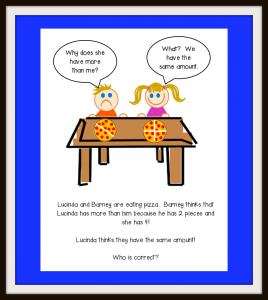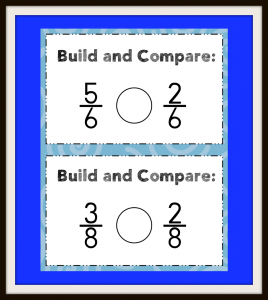
Teaching Equivalency and Comparisons of Fractions is a lot easier than you think!
 This unit starts by teaching students to look at the size of the object, pictorial model or number line and make sure they are comparing something that is the same size (3.3G). Students need to pay attention to the whole when dealing with fractions. They also need to make sure that the portion of the whole is the same. We start with area models and look for equivalent models. Area models are a great place to start because we use them non-stop in 3rd grade!
This unit starts by teaching students to look at the size of the object, pictorial model or number line and make sure they are comparing something that is the same size (3.3G). Students need to pay attention to the whole when dealing with fractions. They also need to make sure that the portion of the whole is the same. We start with area models and look for equivalent models. Area models are a great place to start because we use them non-stop in 3rd grade!
Equivalency on a number line is the next step. Students really struggle with this one! I found an old box of overhead transparencies at the school to make number lines the students could line up on top of each other and see all of the lines. (Side note: I had to take them to Office Depot to have them made- the copy machine gets really hot and jammed when these go through…opps!) This will make teaching with denominators 2,4 and 8 and 3 and 6 easier. The student can see 1/2 and 2/4 were lined up! It is also great discussion about factors! Work with horizontal and vertical number lines. Click this link for a set of vertical and horizontal number lines. After some practice students will be ready to compare!
In 3rd grade, our students are comparing fractions that have the same numerators or the same denominators. This helps students develop reasoning about the size of the fraction. This is a very important concept and most of the time it is skipped! Sometimes the butterfly method (cross multiplying the numerator and denominator) is taught so that kids get the right answer, but they will miss out on the understanding of how big a fraction really is! Don’t be tempted to take the shortcut! Start by building two fractions with the same manipulative (same size whole) that has the same denominator. Students can see which fraction is larger or smaller. This is a great time to estimate closer to 0, 1/2 or 1 whole even though it is not a 3rd grade skill. Then move to comparing fractions with the same size numerator. Make sure you use the same manipulative! The whole still needs to be the same. Comparing the numerators brings up an excellent misconception for students. This is where they learn that 1/4 is smaller than 1/3 because the whole was divided into more parts! The more parts something is split into the smaller the parts. They know this concept- ask them if they want to share a candy bar with two people or 8 people! They just haven’t connected it to the written fraction!
This unit includes models models and more models! It even has the dreaded paper folded strip students struggle with so much! Each lesson is written with the objective, a connection, direct teach, active engage, closure and an exit ticket. Guided math lesson are hands on! The lessons are great for reteach and intervention- each TEKS is broken down into manageable parts with intervention and enrichment ideas/skills to help you differentiate.
If you want your weekends back- no time spent writing lesson plans and hunting activities aligned to the TEKS- click the image below to visit my Teachers Pay Teachers store or click the Shopify button to purchase!
https://johnpohly.wistia.com/medias/89iyffh7av?embedType=async&videoFoam=true&videoWidth=640


